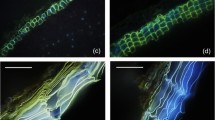Abstract
The water permeabilities of 3174 astomatous, isolated cuticular membranes from Citrus aurantium L. leaves were studied. Trees were grown in environmental chambers at temperatures ranging from 15 to 35° C and humidities of 50% and 90%. Photosynthetically active radiation was 500–1000 μmol photons·m−2· s−1. The different growing conditions had no effect on the water permeability of the membranes. However, storing isolated cuticular membranes at 8° C for up to 112 weeks decreased their water permeability, and it is argued that this is a consequence of the healing of defects between wax crystallites, and also indicates the dynamic nature of cuticular waxes.
Similar content being viewed by others
Abbreviations
- CM:
-
cuticular membranes
References
Baker, E.A. (1974) The influence of environment on leaf wax development in Brassica oleracea var. gemmifera. New Phytol. 73, 955–966
Baker, E.A. (1982) Chemistry and morphology of plant epicuticular waxes. In: The plant cuticle, pp. 139–165, Cutler, D.F., Alvin, K.L., Price, C.E., eds. Academic Press, London
Baker, E.A., Hunt, G.M. (1981) Developmental changes in leaf epicuticular waxes in relation to foliar penetration. New Phytol. 88, 731–747
Becker, M., Kerstiens, G., Schönherr, J. (1986) Water permeability of plant cuticles: permeance, diffusion and partition coefficients. Trees 1, 54–60
Bengtson, C., Larsson, S., Liljenberg, C. (1978) Effects of water stress on cuticular transpiration rate and amount and composition of epicuticular wax in seedlings of six oat varieties. Physiol. Plant. 44, 319–324
Bukovac, M.J. (1976) Herbicide entry into plants. In: Herbicides, physiology, biochemistry, ecology, pp. 335–364, Audus, L.J., ed. Academic Press, London
Bukovac, M.J., Flore, J.A., Baker, E.A. (1979) Peach leaf surfaces: changes in wettability, retention, cuticular permeability, and epicuticular wax chemistry during expansion with special reference to spray application. J. Am. Soc. Hortic. Sci. 104, 611–617
Eckl, K., Gruler H. (1980) Phase transitions in plant cuticles. Planta 150, 102–113
Fox, R.C. (1958) The relationship of wax crystal structure to the water vapor transmission rate of wax films. J. Tech. Assoc. Pulp. Paper Ind. 41, 283–289
Franz, H.P., Bartusch, W., Heiss, R. (1972) Untersuchungen über die Wasserdampfdurchlässigkeit paraffinbeschichteter Papiere. Fette, Seifen, Anstrichm. 74, 469–475
Freeman B, Albrigo LG, Biggs RH (1979) Cuticular waxes of developing leaves and fruit of blueberry, Vaccinium ashei Reade cv. Bluegem. J. Am. Soc. Hortic. Sci. 104, 398–403
Geyer, U., Schönherr, J. (1988) An in vitro test for effects of surfactants and formulations on permeability of plant cuticles. In: Pesticide formulations: innovations and developments, pp. 22–33, Cross, B., Scheer, H.B., eds. American Chemical Society, Symposium Series 371, Washington DC
Haas, K. (1977) Einfluß von Temperatur und Blattalter auf das Cuticularwachs von Hedera helix. Biochem. Physiol. Pflanz. 171, 25–31
Hunt, G.M., Baker, E.A. (1982) Developmental and environmental variations in plant epicuticular waxes: some effects on the penetration of naphthylacetic acid. In: The plant cuticle, pp. 279–292, Cutler, D.F., Alvin, K.L., Price, C.E., eds. Academic Press, London
Jeffree, C.E. (1986) The cuticle, epicuticular waxes and trichomes of plants with reference to their structure, function and evolution. In: Insects and the plant surface, pp. 23–64, Juniper, B.E., Southwood, T.R.E., eds. Edward Arnold, London
Kerler, F., Schönherr, J. (1988) Permeation of lipophilic chemicals across plant cuticles: prediction from partition coefficients and molar volumes. Arch. Environ. Contam. Toxicol. 17, 7–12
Kerstiens, G. (1988) Funktionelle Veränderungen der pflanzlichen Kutikula durch Ozon. Thesis, Technische Universität München, FRG
Larsson, S., Svenningsson, M. (1986) Cuticular transpiration and epicuticular lipids of primary leaves of barley (Hordeum vulgare). Physiol. Plant. 68, 13–19
O'Toole, C.T., Cruz, R.T., Seiber, J.N. (1979) Epicuticular wax and cuticular resistance in rice. Physiol. Plant. 47, 239–244
Possingham, J.V., Chambers, T.C., Radler, F., Grncarevic, M. (1967) Cuticular transpiration and wax structure and composition of leaf and fruit of Vitus vinifera. Austr. J. Biol. Sci. 20, 1149–1153
Riederer, M., Schönherr, J. (1985) Accumulation and transport of (2,4-dichlorophenoxy)acetic acid in plant cuticles: II. Permeability of the cuticular membrane. Ecotoxicol. Environ. Safety 9, 196–208
Schönherr, J. (1976) Water permeability of isolated cuticular membranes: the effect of cuticular waxes on diffusion of water. Planta 131, 159–164
Schönherr, J. (1982) Resistance of plant surfaces to water loss: transport properties of cutin, suberin and associated lipids. In: Encyclopedia of plant physiology, vol. 12B: Physiological plant ecology, vol. 2, pp. 153–179, Lange, O.L., Nobel, P.S., Osmond, C.B., Ziegler, H., eds. Springer, Berlin Heidelberg New York
Schönherr, J., Lendzian, K. (1981) A simple and inexpensive method of measuring water permeability of isolated plant cuticular membranes. Z. Pflanzenphysiol. 102, 321–327
Schönherr, J., Mérida, T. (1981) Water permeability of plant cuticular membranes: the effects of humidity and temperature on the permeability of non-isolated cuticles of onion bulb scales. Plant Cell Environ. 4, 349–354
Schönherr, J., Riederer, M. (1986) Plant cuticles sorb lipophilic compounds during enzymatic isolation. Plant Cell Environ. 9, 459–466
Schönherr, J., Riederer, M. (1988) Foliar penetration and accumulation of organic chemicals in plant cuticles. Rev. Environ. Contam. Toxicol. 108, 1–70
Shafer, W.E., Schönherr, J. (1985) Accumulation and transport of phenol 2-nitrophenol and 4-nitrophenol in plant cuticles. Ecotoxicol. Environ. Safety 10, 239–252
Sitte, P., Rennier, R. (1963) Untersuchungen an cuticularen Zellwandschichten. Planta 60, 19–40
Svenningsson, M., Liljenberg, C. (1986) Changes in cuticular transpiration rate and cuticular lipids of oat (Avena sativa) seedlings induced by water stress. Physiol. Plant. 66, 9–14
Whitecross, M.I., Armstrong, D.J. (1972) Environmental effects on epicuticular waxes of Brassica napus. Austr. J. Bot. 20, 87–95
Author information
Authors and Affiliations
Rights and permissions
About this article
Cite this article
Geyer, U., Schönherr, J. The effect of the environment on the permeability and composition of Citrus leaf cuticles. Planta 180, 147–153 (1990). https://doi.org/10.1007/BF00193989
Accepted:
Issue Date:
DOI: https://doi.org/10.1007/BF00193989




